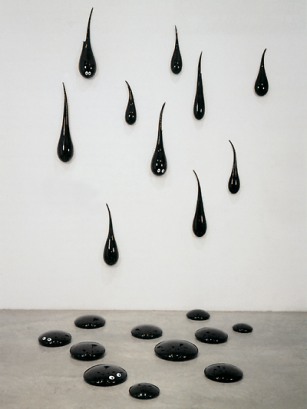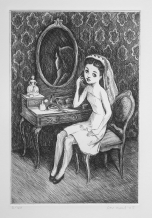| Zeitschrift Umělec 2003/1 >> Before and After the Opening | Übersicht aller Ausgaben | ||||||||||||
|
|||||||||||||
Before and After the OpeningZeitschrift Umělec 2003/101.01.2003 Jasmina Čubrilo | venice biennale | en cs |
|||||||||||||
|
"1. Looking a little bit backward
Harald Szeemann, the director of last year’s Venice Biennial, started his introductory text in the catalogue accompanying this event with the following question: “Do such large exhibitions still make sense?” Apart from Szeemann’s implicit affirmative, which justifies the very existence of this exhibition by means of elaborating its concept and the choice of presented works, it seems that such exhibitions make sense only if the system that they represent can provide favorable conditions. In other words, the art system requires these forms of global and group presentation in order to function. These forms verify its existence and enable its survival. Exhibitions like the Biennial are the central places of power distribution, information (capital) flow and exchange, conformism and necessary excess positions that either vanish in the course of time or are de-radicalized by the system thanks to its adaptability. Nevertheless, such events are always expected with impatience, because they present various levels of reality and different aspects of contemporary art, according to a concept established by a group of experts engaged to carry out each and every one of them. Speaking of the world of art, one issue has to be made clear: it is the same system that animates us (in-) directly to do what we do, to create what we create, in the way we want it. 2. Retrospective/searching The Venice Biennial is a challenging phenomenon. Primarily, and paradoxical though it may be, the level of its challenging nature does not depend upon the quantity of radicalism or art practices based on radical criticism in the scope of a Biennial edition. It rather inclines to the historic fact that it is the oldest world exhibition with an international concept, and because of that, it has become a frame of reference in regard to which other international exhibitions have defined their profiles and distinctive characteristics in the end. On the other hand, the vestiges of the past (this event was initiated in the nineteenth century) can be noticed still in the concept of the Venice Biennial, because it gives enough scope for “national exercises of modernity” (Bojana Pejic) even today. The very eclectic ambience of the park, where the Biennial takes place every two years, reflects the spirit of the times it was initiated in as well as the steadiness/flexibility of its concept. The architecture of national pavilions is predominantly based on national architectural stereotypes, ranging from the neo-classicist façade of the central exhibition pavilion, which represent the well-known model of “art temple” applied in designing museums and similar “temples,” such as libraries, banks or administrative buildings; through the British neo-Palladian facade, and the French reflection on Petit Trianon, to the Swedish transparent, steal and glass “box” etc. Originally, national selections were exhibited in the central pavilion. In 1914, the construction of national pavilions started. The law regulated their status as well. Giardini gained its final form between 1928 and 1938. The Venice Biennial is one of the rare international exhibitions, if not the only one, that links national identity to art so openly and almost inextricably, regardless of more than decade-long multicultural and trans-national processes. For example, the members of the European Union haven’t left their pavilions, ergo the principle of presenting their national and cultural sovereignty and solidity. On the other hand, the same processes that actively take part in fragmenting and/or creating new boundaries, have in a way “decentralized” the very exhibition. A number of new countries were compelled to find locations for presenting their national cultures outside the “diplomatic” ambience of Giardini, that is, in the old part of the city, in some late-Gothic, Renaissance and Baroque buildings and in keeping with their financial means. If we add the tendency of inviting guests to exhibit in the national selections, then we must conclude that the Biennial is adapting to a multicultural situation. More precisely, it is adapting to a trend where multicultural narratives try to assimilate the Biennial. This important event continues to be relevant, regardless of the fact that its actuality, competence and even political correctness are being disputed. In that context, the Biennial is considered to be a special kind of art history, because various forms of cultural policy on presenting national artistic identity, concepts, preferences as well as the positions of art critics and experts in general, who created and carried out the past Biennials, modeled the narrative of this event. To mark the Biennial as a promoter of bourgeois or mediocre taste is as wrong as to grasp it as a promoter of the avantgarde. Numerous phenomena in contemporary art had not been promoted at the Biennial at all. Some of them were presented, perhaps, in the scope of a retrospective a few years later. On the other hand, these phenomenon were brought up thanks to a theme or single exhibitions, accompanying the main program on the Biennial. From time to time, the Biennial was indeed the final merit of tendencies in art by means of theme exhibitions held in the central pavilion or a national one. For example, Art Informel in 1960, Pop art in 1964 (Castelli-Sonnanbend’s campaign played an important part), and Kinetic art in 1966 were promoted at the Venice Biennial. Consequently, ambivalence is a permanent state of affairs, a constant that links all the Biennials. If that ambivalence meant in the past: to oscillate between bourgeois taste and avantgarde spirit, today it represents a compromise between an old, prestigious institution of haut culture and contemporary political, geographical, economic, technological, ideological and media circumstances that incessantly change. In fact, the Biennial possesses an air of democracy, only in appearance. Basically, it remains an “elite salon” and a special “database” within the world of art. This event distinguishes itself quite clearly from other world attractions, such as: Documenta, Manifesta, Biennials held in Sao Paolo, Lyon, Tirana, Cetinje etc. In spite of the efforts made in 1968 to radically change it (awards were recalled), the Venice Biennial did not possess any defined time frame. It became elusive. The entire event took place on about 30 locations. Everything was on the go. A visitor had to be present in the city the whole time this event took place. Between 1976 and 1978, it returned into its old “institutional” frames. The identity of the Biennial, modeled in the first decades of the twentieth century, participates in modern times in an authentic way. Therefore, it represents an important happening that all other/ recently established art events couldn’t ignore. Two years ago, in the Belgrade weekly NIN I read the statement of Reinhardt Schwab, a young artist from Dresden, acknowledging that he would never come to the “old-fashion Venice Biennial,” although he greatly respected Szeemann. This statement is one of the erroneous readings and critiques of the position of the Biennial in the world of art. The question is not whether the Biennial is out-dated, but the question lies in the ways it uses its license to verify, evaluate and model art history. The problem with such high budget projects is that they understand a certain code of manners. A performance by Tanja Ostojic, called I’ll Be Your Angel, carried out in the official opening of the Biennial in 2001, is a good example how every aspect of noblesse oblige in Venice is being scrutinized: from the mystification of an artwork, which was carried out just for Szeemann, through a provocative escort analogy with the relation between a (geographically, culturally and originally marginalized) male/female artist and (centrally positioned) male/ female curator, to a glamorous Lacroix costume design for the glamorous set up design in Giardini, Venice. 3. (F) actuality Generally speaking, international exhibitions are organized for the purpose of exchanging ideas and experiences. So they do not only privilege concepts that are institutionally “accepted,” but they are in the position to provide an adequate scope for those concepts that are institutionally “unaccepted” as well. Every institutionalized art gathering, as well as any other system, is inclined to create circumstances for its self-reflection and its self-criticism because, only then, it can avoid reproducing the same things. Finally, it acknowledges itself, thereby obtain- ing the merit of a referential event. Above all, the Biennial was a product of different national as well as prevailing, homogenous, universalizing forms of presentation policy till the last decade of the twentieth century. Globalization with its contradictory processes — the rearticulation of hegemony, the homogenization and diffusion of differences, appropriation, assimilation, superficial appreciation — changes the Biennial in a way; more precisely, it confronts the Biennial with new kinds of problems. A possible, and yet the most common, result of all these processes, as Gerardo Mosquero singles out, is the fact that artists who exhibit on the global level and come from different parts of the world reflect only the quantity of internationalization. More often, this massiveness represents a parameter of that almighty process of absorption. It does not show how artists contribute to the transformation of a hegemonic and restrictive situation. The Biennial holds the position of a centralized international circulation of concepts, works, curators and artists in the complex scope of real and disparate worlds. In that context, the Biennial would not be different from other world mega-events that are very ambitious for different reasons if the “anthropological sampling” did not occur in the ambience with a very firm historic background filled with every sort of controversial passé-actualité. The entire structure of the Biennial — a combination of non-national problemoriented and theme exhibitions and national selections that produces a specific assemblage of diverse contexts, cultures, art practices and productions — scrutinizes three aspects in wider terms: personal as political, political as economical, and political as political. Disregarding the concepts of national selections, in other words the critical evaluations of the mechanism of issuing a license for creating/ producing a national mirror (that is, for projecting one’s own personal, professional and national narcissism), and disregarding sense, significance and meaning/consequences of (in)compatibility, we enter an intensive field of conflict between those who are (get) plugged and those who are not plugged, more precisely a field of highly intense confrontation with global narcissism and with the homogenizing effect defined by Naomi Klein as mono-multiculturalism. We also en- counter new strategies of critic interventions in remodeling the language and references of the given cultures/global culture. In fact, every huge international exhibition actualizes and raises the issue of an asymmetry between “curating cultures” and “curated cultures,” as Mosquero put it. Every event, including the Biennial, represents a place (lieu) in terms of De Certeau, an ordered and ordering system realized in “spatial practices,” that is, in every single edition of the Biennial. In other words, events like the Biennial are gatherings where one absorbs ideas, experiences, views and the work of both curators and artists. These gatherings also authenticate tendencies in culture and society. Later they reflect back these “canonized” tendencies into the field of culture as the “emancipation” of culture rather than its “expansion.” In a way, this logic is reminiscent of the one applied in branding: one looks for the things that already exist; they are partially institutionalized and recognized (from almost unknown to firmly established ones), then one actualizes additionally the “found” and brings it back as very up-to-date. Weren’t the success and prestige of the past Biennials grasped and compared with the level of offered actuality, more precisely, with the balance established between con- formism and provocation, where-by provocation affirms not just actuality, but itself as well? History teaches us that art can function as an effective mediator of change or resistance towards hegemonic powers. But, it can slip easily into the trap of becoming just a “beautiful” and irrelevant element if it loses its sharp edges and ability to confront itself. In the course of the twentieth century, radicalized and/or politicized arts and art practices essentially had a common strategy - to be a dialectical opposition. The problem with negation or inversion is that they rarely change perception, because they leave the basic structure or system intact. In return, the system manages to absorb such phenomena/messages, so it cannot become an effective strategy of resistance. However, an inversion can produce dislocations. It can be effective if other pressures support it in its efforts to produce new meanings. Michel Serres speaks of an internal, but not from an already institutionalized position of the opposite Other. He passes this internal action onto the third person, a “demon,” “parasite,” “Don Juan” and “Hermes.” The third person is the integral part of the system. By entering a closed circuit, he blurs intelligible messages, changes their meanings, turns information into misinformation, and creates noise in order to reorganize/intervene existing correlations. At this point, it is quite logical to ask: who plays this part in the world of art — the curator or the artist? This dilemma is actually a delusion, a false construction, because both curators and artists mediate between everyday life experiences, (non)institutionalized cultural models, cultural/art institutions and the wider public. If the artist as the “third man” reinterprets and intervenes in the field of the given culture, then a curator as the “parasite” and “Hermes” introduces the artist to the institution (or is it vice versa, to paraphrase Kynaston McShine’s dilemma). The curator is obliged to invest his passion and knowledge. In such a manner, she/he participates in the discourse that is generated by an artist’s work or the intention and context of art production. Therefore, a curator can have a number of identities — such a list is offered in the book called Fresh Cream, Contemporary Art in Culture. The authors of this book state that a curator can be a local expert, nomad, “typical global person” (Hou Hanru), spokesman, selector/ promoter and entrepreneur. But, taking into consideration the current models of redefining the freedom of expression in the domain of art, it seems that it is more adequate to define the curator as a go-between/facilitator, “agent provocateur” (Dan Cameron). 4. Post scriptum/Short notice on what I have seen For this year’s spectacle named Sogni e Conflitti, La dittatura dello spettatore, Francesco Bonami was appointed art director. He invited a great number of curators and artists/curators, coming from various milieus and belonging to various generations (Hou Hanru, Igor Zabel, Carlos Basualdo, Molly Nesbit, Hans Ulrich Obrist, Rikrit Tiravanija, Catherine David, Gabriel Orozco, Gilane Tawardos, Daniel Birnbaum, Massimiliano Gioni), to present single, author or co-authored exhibitions, that is to present art spaces as fragmentary representations of existing geo-political and cultural (non) units. A special art cartography was thus produced, where the documentary interweaves with fictions, information with their interpretations, and indirect experience with the direct. In short, this year’s Biennial with all its compromises strikes a happy and solid balance, gets stuck between the global and local, the mirror effect and critical reflections. It is still a relevant source of information on the current mainstream and its confronting sides, excesses, ambivalences, (ex)controversies and parallel existence of differences. In a way, thanks to an omni-present and diverse anthropological engagement, it can be associated with the concepts of outstanding world exhibitions held in the late nineteenth century. …and what more… “Our desire does not desire satisfaction: our desires desire desiring. The greatest threat to a desire is a fixed, steady, final moment of fulfilment…” Zygmunt Bauman Belgrade, May and the end of June 2003 "
01.01.2003
Empfohlene Artikel
|
|||||||||||||
|
04.02.2020 10:17
Letošní 50. ročník Art Basel přilákal celkem 93 000 návštěvníků a sběratelů z 80 zemí světa. 290 prémiových galerií představilo umělecká díla od počátku 20. století až po současnost. Hlavní sektor přehlídky, tradičně v prvním patře výstavního prostoru, představil 232 předních galerií z celého světa nabízející umění nejvyšší kvality. Veletrh ukázal vzestupný trend prodeje prostřednictvím galerií jak soukromým sbírkám, tak i institucím. Kromě hlavního veletrhu stály za návštěvu i ty přidružené: Volta, Liste a Photo Basel, k tomu doprovodné programy a výstavy v místních institucích, které kvalitou daleko přesahují hranice města tj. Kunsthalle Basel, Kunstmuseum, Tinguely muzeum nebo Fondation Beyeler.
|








































 New book by I.M.Jirous in English at our online bookshop.
New book by I.M.Jirous in English at our online bookshop.
Kommentar
Der Artikel ist bisher nicht kommentiert wordenNeuen Kommentar einfügen